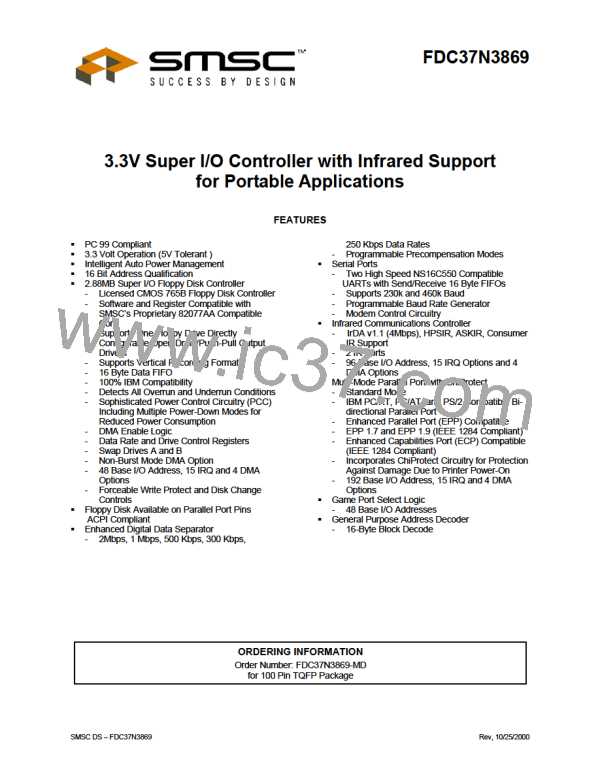Restarting the DMA is accomplished by enabling DMA in the host, setting dmaEn to 1, followed by setting serviceIntr
to 0.
DMA Mode - Transfers from the FIFO to the Host
(Note: In the reverse mode, the peripheral may not continue to fill the FIFO if it runs out of data to transfer, even if the
chip continues to request more data from the peripheral).
The ECP activates the PDRQ pin whenever there is data in the FIFO. The DMA controller must respond to the
request by reading data from the FIFO. The ECP will deactivate the PDRQ pin when the FIFO becomes empty or
when the TC becomes true (qualified by nPDACK), indicating that no more data is required. PDRQ goes inactive
after nPDACK goes active for the last byte of a data transfer (or on the active edge of nIOR, on the last byte, if no
edge is present on nPDACK). If PDRQ goes inactive due to the FIFO going empty, then PDRQ is active again as
soon as there is one byte in the FIFO. If PDRQ goes inactive due to the TC, then PDRQ is active again when there
is one byte in the FIFO, and serviceIntr has been re-enabled. (Note: A data underrun may occur if PDRQ is not
removed in time to prevent an unwanted cycle).
Programmed I/O Mode or Non-DMA Mode
The ECP or parallel port FIFOs may also be operated using interrupt driven programmed I/O. Software can determine
the writeIntrThreshold, readIntrThreshold, and FIFO depth by accessing the FIFO in Test Mode.
Programmed I/O transfers are to the ecpDFifo at 400H and ecpAFifo at 000H or from the ecpDFifo located at 400H,
or to/from the tFifo at 400H. To use the programmed I/O transfers, the host first sets up the direction and state, sets
dmaEn to 0 and serviceIntr to 0.
The ECP requests programmed I/O transfers from the host by activating the PINTR pin. The programmed I/O will
empty or fill the FIFO using the appropriate direction and mode.
Note: A threshold of 16 is equivalent to a threshold of 15. These two cases are treated the same.
Programmed I/O - Transfers from the FIFO to the Host
In the reverse direction an interrupt occurs when serviceIntr is 0 and readIntrThreshold bytes are available in the
FIFO. If at this time the FIFO is full it can be emptied completely in a single burst, otherwise readIntrThreshold
bytes may be read from the FIFO in a single burst.
readIntrThreshold =(16-<threshold>) data bytes in FIFO
An interrupt is generated when serviceIntr is 0 and the number of bytes in the FIFO is greater than or equal to (16-
<threshold>). (If the threshold = 12, then the interrupt is set whenever there are 4-16 bytes in the FIFO.) The PINT pin
can be used for interrupt-driven systems. The host must respond to the request by reading data from the FIFO. This
process is repeated until the last byte is transferred out of the FIFO. If at this time the FIFO is full, it can be
completely emptied in a single burst, otherwise a minimum of (16-<threshold>) bytes may be read from the FIFO in a
single burst.
Programmed I/O - Transfers from the Host to the FIFO
In the forward direction an interrupt occurs when serviceIntr is 0 and there are writeIntrThreshold or more bytes free in
the FIFO. At this time if the FIFO is empty it can be filled with a single burst before the empty bit needs to be
re-read. Otherwise it may be filled with writeIntrThreshold bytes.
writeIntrThreshold = (16-<threshold>) free bytes in FIFO
An interrupt is generated when serviceIntr is 0 and the number of bytes in the FIFO is less than or equal to
<threshold>. (If the threshold = 12, then the interrupt is set whenever there are 12 or less bytes of data in the FIFO.)
The PINT pin can be used for interrupt-driven systems. The host must respond to the request by writing data to the
FIFO. If at this time the FIFO is empty, it can be completely filled in a single burst, otherwise a minimum of (16-
<threshold>) bytes may be written to the FIFO in a single burst. This process is repeated until the last byte is
transferred into the FIFO.
AUTO POWER MANAGEMENT
SMSC DS – FDC37N3869
Page 87
Rev. 10/25/2000

 SMSC [ SMSC CORPORATION ]
SMSC [ SMSC CORPORATION ]